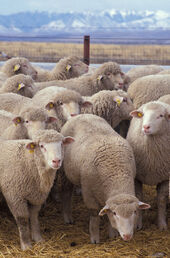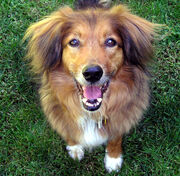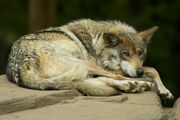| Line 36: | Line 36: | ||
==Aspects of captivity by species== |
==Aspects of captivity by species== |
||
| − | [[Aspects of captivity in |
+ | *[[Aspects of captivity in cats]] |
| + | *[[Aspects of captivity in dogs]] |
||
| + | *[[Aspects of captivity in dolphins]] |
||
| + | *[[Aspects of captivity in elephants]] |
||
| + | *[[Aspects of captivity in fish]] |
||
| + | *[[Aspects of captivity in pandas]] |
||
| + | *[[Aspects of captivity in monkeys and apes]] |
||
== See also == |
== See also == |
||
Revision as of 15:24, 16 April 2009
Assessment |
Biopsychology |
Comparative |
Cognitive |
Developmental |
Language |
Individual differences |
Personality |
Philosophy |
Social |
Methods |
Statistics |
Clinical |
Educational |
Industrial |
Professional items |
World psychology |
Animals · Animal ethology · Comparative psychology · Animal models · Outline · Index

Animal husbandry
Animals that live under human care are in captivity. Captivity can be used as a generalizing term to describe the keeping of either domesticated animals (livestock and pets) or wild animals. This may include for example farms, private homes and zoos. Keeping animals in human captivity and under human care can thus be distinguished between three primary categories according to the particular motives, objectives and conditions.
Categories
Animal husbandry
Keeping and breeding livestock domesticated for economic reasons in farms, stud farms and similar establishments.
Pet keeping
Keeping pets domesticated for personal reasons mostly at private homes.
Wild animal keeping
Keeping wild, non-domesticated animals in menageries, zoos, aquaria, marine mammal parks or dolphinariums and similar establishments for various reasons:
- prestige (illustration of wealth and power)
- entertainment and amusement
- science
- education
- conservation biology

Dogs and other pets are kept for personal companionship and outdoor activities
History
The domestication of animals is the oldest documented keeping of animals in captivity. The result was habituation of wild animal species to survive in the company of, or by the labor of, human beings. Domesticated species are those whose behaviour, life cycle, or physiology has been altered as a result of their breeding and living conditions under human control for multiple generations. Probably the earliest known domestic animal has been the dog, likely as early as 15000 BC among hunter-gatherers in several locations.
Throughout history not only domestic animals as pets and livestock were kept in captivity and under human care, but also wild animals. Some were failed domestication attempts. Also, in past times, primarily wealthy men, aristocrats and kings collected wild animals for various reasons. Contrary to domestication, the ferociousness and natural behaviour of the wild animals were preserved and exhibited. Today's zoos claim other reasons for keeping animals under human care: conservation, education and science.

A critically endangered Mexican Gray Wolf is kept in captivity for breeding purposes.
Behavior of animals in captivity
Captive animals, especially those which are not domesticated, sometimes develop repetitive, apparently purposeless motor behaviors called stereotypical behaviors. These behaviors are thought to be caused by the animals' abnormal environment. Many who keep animals in captivity, especially in zoos and related institutions and in research institutions, attempt to prevent or decrease stereotypical behavior by introducing novel stimuli, known as environmental enrichment.
Aspects of captivity by species
- Aspects of captivity in cats
- Aspects of captivity in dogs
- Aspects of captivity in dolphins
- Aspects of captivity in elephants
- Aspects of captivity in fish
- Aspects of captivity in pandas
- Aspects of captivity in monkeys and apes
See also
Animal Husbandry:
Pet Keeping:
- Pet
- European Convention for the Protection of Pet Animals
Wild Animal Keeping:
- Menagerie
- Zoological garden
- Aquarium
- Marine mammal park
- Dolphinarium
- Cultural history
Cruelty to Animals and Animal Welfare:
- Animal welfare
- Cruelty to animals
- World Society for the Protection of Animals
See also
References
External Links
- Pet-Abuse.com
- World Association of Zoos and Aquaria
- New York Zoos and Aquarium
- WSPA international website
| This page uses Creative Commons Licensed content from Wikipedia (view authors). |